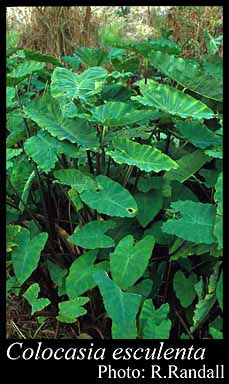- Reference
- Schott & Endl., Melet.Bot. 18 (1832)
- Conservation Code
- Not threatened
- Naturalised Status
- Mixed (Native in Part of Range, Naturalised Elsewhere)
- Name Status
- Current
Tuberous, partly submerged perennial, herb, 0.2-1(-3) m high. Fl. yellow, Mar or Jul. Black sand. Creeks, seepage areas.

Distribution
- IBRA Regions
- Central Kimberley, Dampierland, Jarrah Forest, Northern Kimberley, Ord Victoria Plain, Swan Coastal Plain, Victoria Bonaparte.
- IBRA Subregions
- Dandaragan Plateau, Keep, Mitchell, Mount Eliza, Northern Jarrah Forest, Pentecost, Perth, Pindanland, Purnululu.
- Local Government Areas (LGAs)
- Armadale, Bayswater, Broome, Derby-West Kimberley, Gingin, Gosnells, Halls Creek, Kalamunda, Wyndham-East Kimberley.
Management Notes (for the Swan NRM Region)
General Biology. Growth form. Geophyte. Life form. Perennial tuberous corm. Reproduction. Cormels, vegetative fragments, stolons. Dispersal. Water, soil. Fire response. Generally survives fire.
Notes. Rarely flowers or sets seeds in south-west Australia. Seed is of low viability.
Additional information. Origin. India, South-east Asia. History of use/introduction. Garden escape, tuber of some forms source of food. Similar exotic species. Alocasia brisbanensis.
Suggested method of management and control. Cut plants to base, paint metsulfuron methyl 0.05 g/L + glyphosate 50 %. Six weeks later carefully spray regrowth with metsufuron methyl 0.05 g/L + glyphosate 1 % + Pulse®. Control in summer when actively growing. Some reports suggest control later in summer is more effective. Read the manufacturers' labels and material safety data sheets before using herbicides. For further information consult the Australian Pesticides and Veterinary Medicines Authority to determine the status of permits for your situation or state.
Management Calendar
| Calendar Type | Jan | Feb | Mar | Apr | May | Jun | Jul | Aug | Sep | Oct | Nov | Dec | Comments |
|---|---|---|---|---|---|---|---|---|---|---|---|---|---|
| Dormant | Y | Y | |||||||||||
| Flowering | Y | Y | Y | Y | O | O | Y | Y | Y | Y | flowering rare in south-west | ||
| Optimum Treatment | Y | Y | Y | Y | Y |
Legend: Y = Yes, regularly, O = Occasionally, U = Uncertain, referred by others but not confirmed.
References
- Atkins, E.O. & Williams, P.S. (2008) Comparison of four techniques to control elephant ear. Journal of Aquatic Plant Management, 46: 158 -162.
- Brooks, K. & Brown, K. (2001) Managing weeds in bushland: Taro (Colocasia esculenta). Environmental Weeds Action Network URL: http://www.environmentalweedsactionnetwork.org.au/ - Accessed December 2007.
- Brown, K. & Brooks, K. (2002) Bushland Weeds: A Practical Guide to their Management. Environmental Weeds Action Network, Greenwood.
- Brown, K. & Brooks, K. (2003) Managing Colocasia esculenta invading the fringing vegetation of a fresh water stream north of Perth. Ecological Management and Restoration, 4 (1): 76-77.
- Brown, K. & Paczkowska, G. (2006) Taro (Colocasia esculenta Schott): Effects of removal on the natural biodiversity of a fresh water wetland and implications for restoration of similar habitats. In In: Papers and proceedings of the 15th Australian Weeds Conference, Adelaide. (eds C. Preston, J.H. Watts and N.D. Crossman).
- Florida Exotic Pest Plants Council (2000) Exotic Pest Plant Database, Colocasia esculenta. URL: http://www.fleppc.org/EDDMapS/ - Accessed December 2007.
- Hussey, B.M.J., Keighery, G.J., Dodd, J., Lloyd, S.G. & Cousens, R.D. (2007) Western Weeds. A guide to the weeds of Western Australia. 2nd Edition. The Plant Protection Society of Western Australia, Victoria Park.